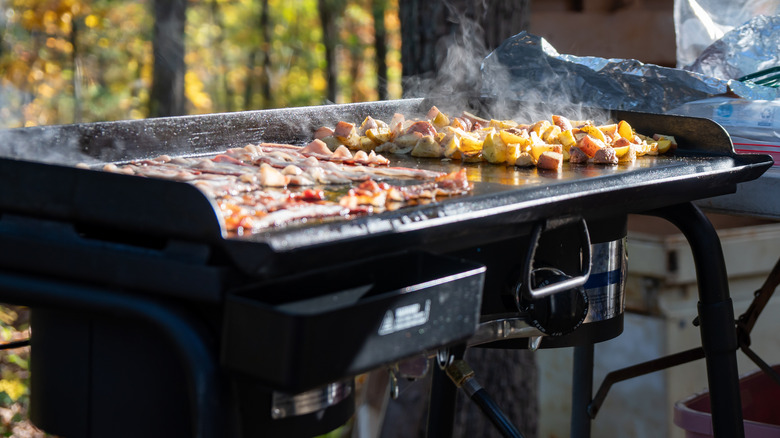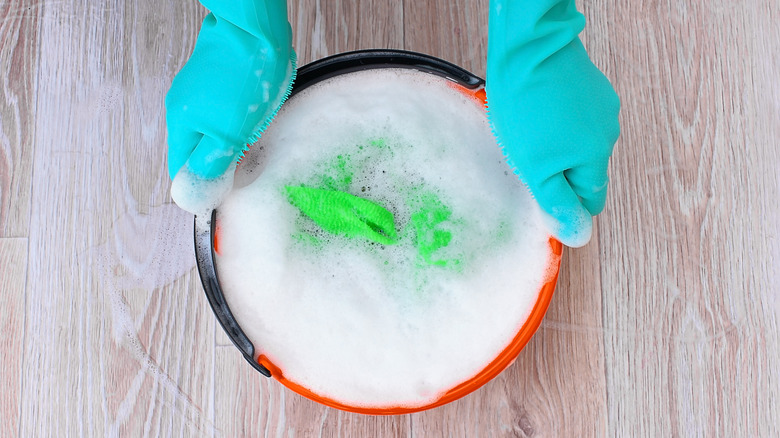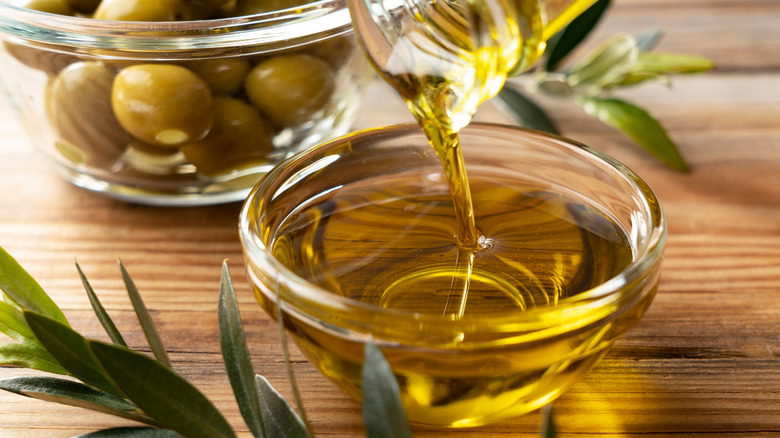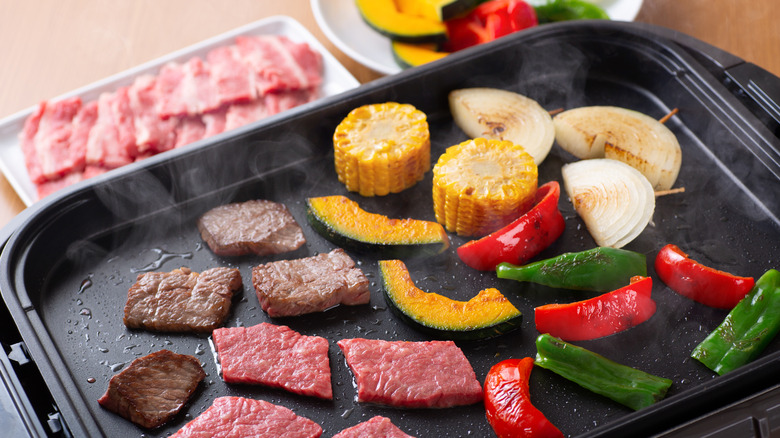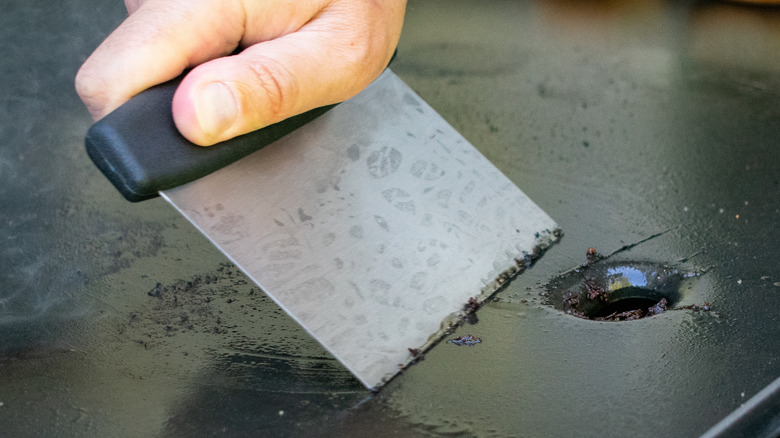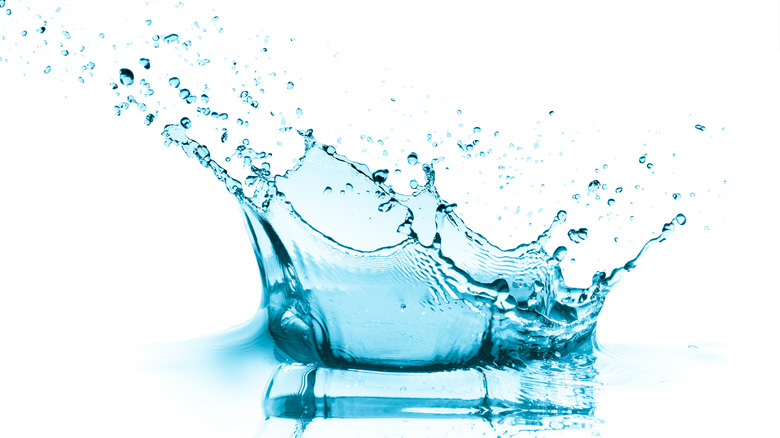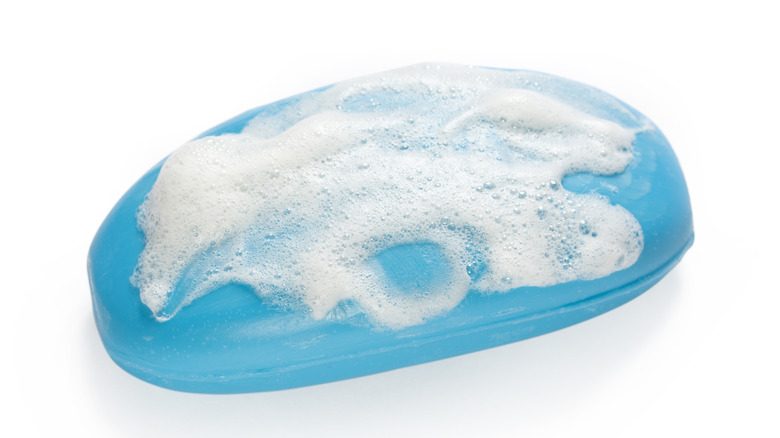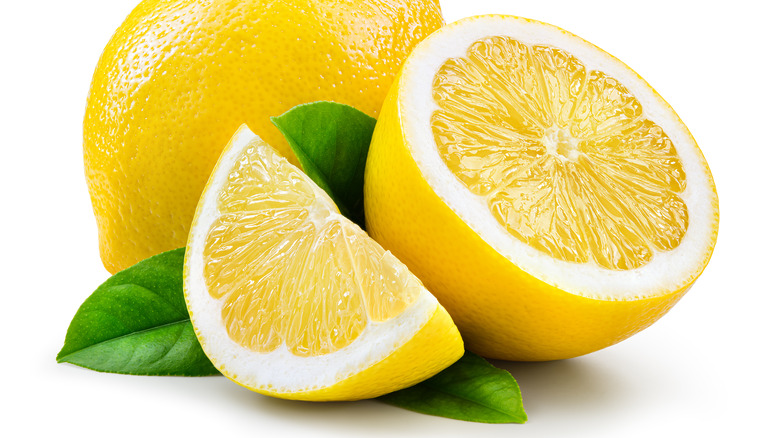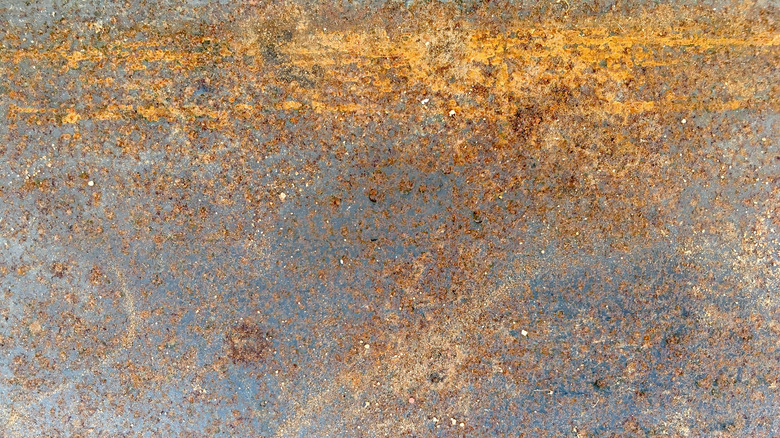How To Clean A Blackstone Griddle
Who doesn't love a good barbeque? Outdoor cooking is a great way to bring people together, whether in the neighborhood, with friends, or just among family. With proper outdoor cooking equipment, you can easily host fun parties or have delightful celebrations within the boundaries of your patio. For years, grills have been the centerpiece of outdoor cooking, but now griddles are taking it to a new level with their easy ability to expand outdoor cooking. The difference between these two outdoor cooking tools? While grills have ridges on their surface or sometimes just consist of bars over an open heat source, griddles have a smooth flat surface, Food Fire Friends explains. Both provide a different flavor and cooking ability for the food cooking on their surface; still, a griddle's flat surface allows the preparation of a much larger range of items beyond the grill, like pancakes or stir-fry. As a result, the opportunities for outdoor cuisine have become endless.
One specific outdoor griddle type that is continuously growing in popularity is the Blackstone griddle. Blackstone griddles come in various sizes and kinds, which allow for the best outdoor cooking experience for your particular activity. Fire Food Friends further informs that for the griddle's exceptional quality and performance, it has a somewhat simple surface to clean. When done properly, cleaning your Blackstone griddle can be an easy process that improves your tool's functionality and maintains its quality. Here are some ways to easily clean your Blackstone griddle.
1. Removing residue and dirt
After purchasing your Blackstone griddle, it's best to quickly wipe down its surface to ensure residue and chemicals, which may have accumulated onto the surface during manufacturing, no longer remain on the cooking area. This step should take place after you assemble the griddle and when it's cold and still unused.
The Spruce suggests starting with 1 to 2 gallons of hot water and adding a couple of dish soap jets. Stir the solution well, then dampen a microfiber cloth in the mix. The cloth should be slightly damp and not overly saturated with the solution. Next, scrub gently over the griddle's surface, rinsing the microfiber cloth frequently as you work over the surface, and rinse the surface with a clean microfiber material, damped with clean, warm water. Once you have cleaned the surface of soap residue, let it air dry completely before attempting to season the griddle.
2. Seasoning your griddle
Before using your Blackstone griddle, it's essential to season its surface properly. Blackstone states that seasoning is what you do to prepare your steal or cast iron cookware for use. This process adds a protective layer to your griddle, preventing rust and creating a natural, lasting, nonstick surface. This process should be done before the first time you use your Blackstone tool and after every use.
Start the seasoning process by putting all their griddle burners on high heat as the equipment needs to be very hot for the seasoning process to work. When you see discoloration on the heated surface, you know you are ready to start the process. As SeaLodge notes, take the conditioner of your choice — flaxseed oil, extra virgin olive oil, or Blackstone's Griddle conditioner — and add a couple of tablespoons to the center of your hot griddle. Spread the seasoning evenly across the entire top using a paper towel, making sure your layers of seasoning are even, smooth, and thin. There should be no build-up or uneven piles of seasoning on your griddle top. When the smoke dies down, repeat the process a few more times before using it for cooking.
3. Regular maintenance
Regular maintenance is key to maintaining your Blackstone griddle in its very best condition. Just as you clean pots and pans after using them for cooking, your griddle should also be cleaned after being used. Nyco mentions that although the main reason to maintain a clean griddle is to prevent contaminants from getting into the food cooked and prepared on its surface, it is also important to keep up regular maintenance for the lasting quality of the equipment. Grease and filth build up over time, forming a sticky film that eventually carbonizes into a difficult-to-remove material.
Eliminating the grease build-up and other food particles will allow the cookware to work more evenly and efficiently while also prolonging its life. Regular maintenance of your griddle should include ridding the surface of residue and reseasoning the top after every use. If your griddle is packed away for long periods, it should be cleared of dust and dirt and reseasoned before being put into use again.
4. Use a griddle scraper
Depending on what you decide to cook on your griddle, the mess can range from a few crumbs to a burnt, sticky mess. In that case, a scraper is a crucial tool to have regardless of the mess that builds up on your griddle surface as you cook. Todd Toven advises rubbing lightly with the scaper on Blackstone Griddles' YouTube channel. You should never scrape aggressively or dig into the griddle because it hurts the nonstick coating you have seasoned onto the top.
While the griddle is still hot, Todd Toven recommends simply scraping residue from the griddle top into the grease cup right after cooking. When you've finished scraping, go over the surface of your griddle again with a paper towel to pick up leftover crumbs and grease. Take extra precautions with a glove, or hold your paper towel with tongs while cleaning to avoid burning yourself. Finish off the aftercare process with a layer of seasoning before turning the griddle off and putting it away.
5. Add water to the tough spots
Sometimes the mess on your griddle top can become burned onto the surface, making it difficult to remove. This can easily happen when you are cooking with sugary substances, such as making stir-fry or pancakes. Instead of attempting to clean it off with just your scraper, try adding some water to your griddle top. Blackstone Griddles' YouTube channel demonstrates how adding water to a caked-on griddle mess can help dissolve the substances, allowing for its easy removal with the scraper.
While the griddle is still hot, add some water to the trouble area. The water will sizzle and dissolve the substance, allowing you to then easily scrape it into your grease cup. Finally, go over the surface of your griddle again with a paper towel to pick up leftover crumbs and grease. Remember to always finish off this process with the usual fresh layer of seasoning.
6. Never use soap
One important Blackstone griddle cleaning tip by Griddle King is to never use soap in between uses. As mentioned, soap is okay to use when you first get the cookware after manufacturing or when pulling it out after a long period, but do not do it when it comes to the routine cleaning process.
Again, your griddle gains protection and its nonstick surface through the process of seasoning. Seasoning is done with your choice of non-animal fat oil, which slowly builds upon the surface of your cookware the more you use it. On the other hand, soap naturally dissolves grease and oils, which is why it is commonly used to clean kitchen appliances and dishes. Unfortunately, this means that using soap on your griddle can break down the seasoning layers that are important for protecting and preserving the nonstick surface of your barbeque tool. To prevent this from happening, remember to never use soap on your griddle or seldomly use it only when it is absolutely necessary.
7. Deep cleaning your Blackstone griddle
It is not required to deep clean your Blackstone griddle. However, deep cleaning is the way to go if you want to remove the old seasoning and start new, clean layers. Flat Top Grilling's YouTube channel highly recommends using all neutral ingredients to clean; this means you need to stay away from harsh chemical cleaning agents in the process of deep cleaning your griddle.
Start by heating your cookware to high heat and squeezing the juice of a few fresh lemons onto the hot surface. You can use water to help mix the lemon juice onto your griddle surface. Vinegar is another natural cleaning agent that you can also apply to the surface of your tool as it helps get rid of build-up easily. Next, let the lemon juice cook on the griddle's surface, loosening up the seasoning in the process. When the liquid has dried up, turn the griddle off and take a scraper to remove the seasoning off the top. After removing residue, you should be left with the original, sparkling surface of your griddle.
8. Removing rust from your griddle
Removing rust from an object may feel like an impossible task, especially when that item is as large as your outside griddle. Instead of trashing your rusted griddle and purchasing another expensive one, Blackstone Griddles has some rust-removing tips they share on their YouTube channel. As such, it's important to keep your griddle away from water when it got rust issues; therefore, do not clean your rusted griddle with any water-based cleaning agents.
Start by putting your cookware on high heat to loosen the debris. After a while, turn the heat off and start cleaning the top with a griddle scraper. Next, lather the surface in cooking oil and scour with a grill stone scrub. Use a paper towel to clean up the debris, and continue the process with the oil and grill stone scrub until all the rust is gone. Finally, your griddle should be ready for use again, so finish by properly reseasoning it.
